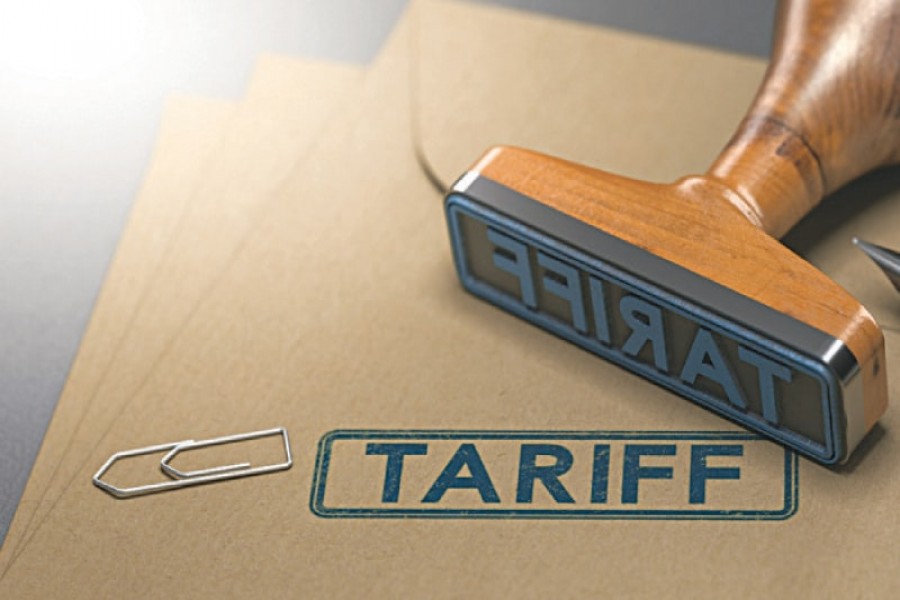
Published :
Updated :

The government has finally prepared a national tariff policy to boost trade competitiveness and enhance consumer welfare. Titled 'National Tariff Policy 2023', it is the first-ever tariff policy of the country, which is expected to remove the anomalies in the existing tariff structure and highlight the country's trade-related priorities.
The objective of the tariff policy, as outlined in the official document, is to enhance the competitiveness of the local industry, expand and diversify the exports, encourage investment and generate employment through trade liberalisation and tariff structure rationalisation for sustainable economic growth.
The policy has also set a nine-point goal in this connection that includes facing the challenges after the country graduates from the Least Developed Country (LDC) category in 2026; expanding and diversifying exports by cutting the reducing the anti-export bias; ensuring a predictable tariff regime to attract foreign and local investments; and enhancing the country's participation in regional and global value chains. The goals also include the reduction of anomalies in the prices of the products in the local market and a load of additional protection for consumer welfare.
Thus, the objectives and goals of the tariff policy are clearly defined and justified to a large extent. Having no written tariff policy for the last five decades was a drawback in the country's trade policy regime, which was flawed for various reasons. It is also true that no trade policy is free of errors or limitations as the policy is always subject to revision from time to time. Trade policy is a complete framework of relevant rules, regulations, stances and deals that need a supportive tariff policy.
A tariff is a customs duty on merchandised imports. Simply put, it is 'a tax imposed by one country on the goods and services imported from another one to influence it, raise revenues, or protect competitive advantages.' Though tariffs are mostly levied on imports, there are cases of export tariffs. According to the Dictionary of Trade Policy Terms (Cambridge University Press/WTO, 2007): 'Tariff gives a price advantage to similar locally-produced goods and raise revenues for the government."
The policy document defined tariff as any duty or tax on export or import that is not trade-neutral. Trade-neutral means any measure unrelated to international trade regulation that does not affect trade flow.
In Bangladesh, import tariffs are traditionally used as a revenue-generation instrument instead of a trade policy tool. This is because import tariffs are easy to impose and administer. Nevertheless, the share of import tariffs in total revenue has declined over the decades. For instance, in FY2001, the share of trade-based taxes was around 55 per cent of the total revenue earnings of the National Board of Revenue (NBR). In FY2020, the ratio reached about 28 per cent as an effect of trade liberalisation.
The average rate of import tariffs has also reduced significantly over the decades. The process of reducing the rate of import tariff started in FY1992. In that year , the rate was around 71 per cent, which came down to 15 per cent in the immediate last fiscal. Moreover, according to Bangladesh Economic Review 2023, (MoF, June, 2023), the country has followed the Most Favoured Nation (MFN) tariff rate since FY2001.
The average rate of protective tariff also reduced to around 31 per cent from 74 per cent during the period under review. The protection rate is still considered high as the coverage of supplementary and regulatory duties has been extended to protect local industry and reduce the loss of revenue earnings.
Again, the World Tariff Profile 2022, published by the World Trade Organization (WTO) last month, showed that Bangladesh's simple average final bound tariff rate is 156.30 per cent, while the average applied MFN rate was 14 per cent in 2021. It means the country has some legal space to enhance the tariff rates, although it will go against the spirit and effort of trade liberalisation. Further liberalisation of trade is the spirit of the tariff policy, although it is not categorically stated in the document.
One key feature of the document is a brief overview of the current status of the country's tariff regime. Here, the government has also acknowledged the problems and limitations of the existing tariff structure. For instance, it showed that the current practice of supplementary duty on imports goes against the 'national treatment' principle of the WTO's General Agreements on Tariffs and Trade (GATT). It is because the country's tax authorities, in many cases, impose a supplementary duty on imported and domestic goods similar in nature at different rates. Again, WTO bars the determination of customs duty based on minimum import price. In some cases, the customs authorities ignore the rule. The policy favours the discontinuation of the practice.
Thus, recognising the current drawbacks of determining and imposing tariffs will help address the problems and simplify the tariff structure in the near future. It is also true that the country's tariff structure has simplified over the years. Now, the number of operative tariff slabs is six, with a maximum rate of 25 per cent.
Another feature of the policy is that it is mainly pro-business and encourages competition in trade and commerce. Discriminatory tariffs constantly undermine the competition and ultimately promote inefficiency. The policy took a stance against the discriminatory tariff.
The policy document outlines a set of suggestions or recommendations as a general course of action to determine tariffs to achieve the goals and targets. The government needs to move ahead to accomplish the guidance necessary to implement the tariff policy.


 For all latest news, follow The Financial Express Google News channel.
For all latest news, follow The Financial Express Google News channel.